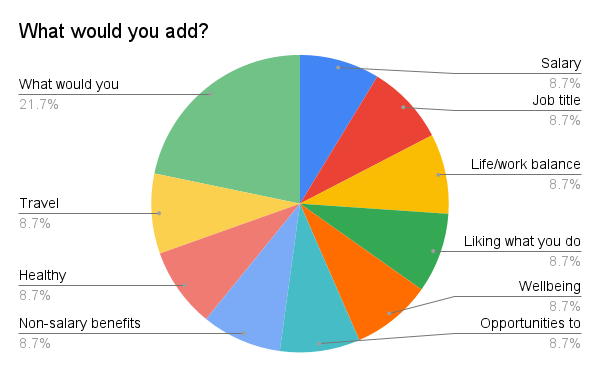At the moment I am writing on Chapter 1 of the Leading Virtual Teams Book, and this chapter covers recruitment and selection as well as starting out as a virtual team and making the move from office-based to virtual.
One of the things I have been thinking about as I am writing, is what makes it rewarding to work in a virtual team and how those of us who are permanently home-based measure success.
This Liz and Mollie visual promoted me to try and make my own pie charts of how we might measure job satisfaction and success at different stages of a career journey. The chart includes salary, job title and liking what you do which I have included in mine below also. Instead of free time I have include life/work balance and I have included wellbeing instead of physical and mental health.

The pie chart has five equal slices labelled Salary, Job title, life/work balance, Liking what you do and Wellbeing, each covering 20%.
To begin with, I have assigned each aspect an equal value. Whilst recruiting for virtual teams over the past few years, I have encountered a lot of different versions of this equation: for example, for some the job title and liking what you do slices of the pie are smaller, and the emphasis is on life/work balance and salary.

The pie chart has five slices labelled Salary (20%), Job title (5%), life/work balance (50%), Liking what you do (5%) and Wellbeing (20%).
This measure is often motivated by the benefits of working from home making commitments outside of work easier to manage, for example caring for family or research. In this case, the benefits the job delivers in terms of flexibility and income outweigh the nature of the work or the position. In this context the ability to work from home is often essential to enabling the individual to work at all, and that can be a big opportunity for virtual teams who are recruiting from a larger pool of talent.

The pie chart has five slices labelled Salary (10%), Job title (20%), life/work balance (10%), Liking what you do (50%) and Wellbeing (10%).
Often, working as part of a Virtual Team can offer opportunities to individuals to do a job they love that isn’t available locally. This is one of the best aspects of recruiting for Virtual Teams, as it can significantly increase the commitment to roles and organisations, performance and job satisfaction. This kind of value system is often found in individuals in highly specialised or creative roles or jobs in particular industries.
What would you add?
There are different slices you could add to this pie, for example opportunities for professional development and learning. Good non-salary benefits or working on a healthy organisational culture. You could add opportunities to travel and having fun.
In addition, what importance we accord to each slice of the pie will change over the course of a career and due to other circumstances. A job that is a good fit at the start, may not be a good fit a few years down the line and working from home may not be a good fit when life changes happen.
A quiet office away from the kids or a workplace that gets you out of the house and meeting people is not easily added to the value proposition for working in a virtual team.
Large or resource rich organisations may be able to offer a blend of working from home and working in the office that increases the spectrum of what you can add to the range of value added. But a blended approach doesn’t necessarily always deliver the best of both worlds, but can result in many people sitting in Zoom meetings in the same building, without any of the benefits of sharing the space with co-workers.

The pie chart has ten slices labelled Salary , Job title , life/work balance, Liking what you do, Wellbeing, Opportunities to learn, non-salary benefits, healthy organisational culture, travel and fun and the biggest slice is labelled: “What would you add?” .
If you are interested in reading more, head to the Leading Virtual Teams Book page where I share extracts from individual chapters in monthly blog posts.